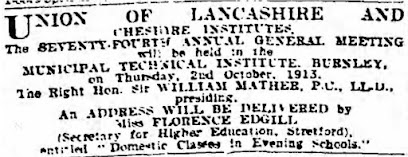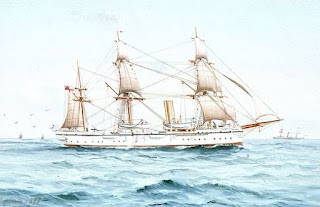I am a dog person, and as it turns out our family are dog people too. Not only that, but I recently discovered that I am the third generation of our family, to have a spaniel as our chosen dog breed. We currently have 2 dogs. One is a flat coated retriever and the other is a 3 year old English Springer Spaniel. I introduced them to you all two weeks back, in my
Family Lore blog post. Ted, the springer, is our second springer. Our first was a beautiful dog named Ollie, who will always be in my heart. He was the most lovely dog, and I still miss him greatly. (He died in the summer of 2019, 3 weeks shy of his 14th birthday.)
Spaniels definitely tug on my heartstrings, and perhaps that is because they are somehow in my blood. My mother had a springer as a young girl. His name was Rip. Here he is, in the back garden of the house where they lived on the south coast of England. Curiously, when we visited the house on a recent visit to the UK we met the current owner, and he has a springer too!
 |
| Rip, in the garden in Southbourne |
Shortly after that visit, whilst going through a pile of photographs and papers with my mum, I came across a rather lovely picture. At first I believed this was my great grandmother Ruth Constance Newell (nee Gambier), but after further pondering I realised it was my great aunt Tara, as a young lady.
I knew Tara as a slight, elderly, single lady, who lived in a sweet little bungalow on the edge of a bluebell woodland in the Sussex countryside. She died in the mid 90's, when I was in my mid 20s, and a university student. It was at her celebration of life that I started to learn about the extraordinary life she had lived.
 |
| Whenever I see a bluebell I think of Tara! |
Tara was born in 1908, in Weymouth, Dorset but by the 1911 census Tara and her family were living in a sea front property in Sheerness, Kent, with 3 members of staff; a cook, a housemaid, and most importantly to Tara and her brother, a nursery maid. Tara and her older brother were raised by their nannies, and were brought down from the nursery each evening to spend a little time with their parents- a very Victorian way to raise children! You'd think that it would have been a big grand house to have so many staff, but looking at the house now, on Google Streetview, the row of 3 story terraced houses don't look all that grand. Perhaps that's thanks to the addition of the wheelie bins in the front yard, and over 100 years of sea wind.
 |
| Marine Parade, Sheerness |
I can't find any record of her in the 1921 census. We do know, from family stories, that she was sent off to a convent boarding school in Belgium, after she had been taught at home by a governess. Perhaps she was in Belgium, enjoying that relative freedom in 1921.
At some point she met, and married John Edward Geoffrey Ransome. John was the son of Stafford Ransome, a journalist and author specialising in reporting on engineering in the British Colonies. He was the author of scintillating works such as 'How to Select Woodworking Machinery', 'Japan in Transition', and 'The Engineer in South Africa'. When John signed up in 1914, to serve in WWI he joined the Kings African Rifles. He was 23, and may have been in Africa at the time that the war started. Considering his father's work out there, it's very possible.
John was considerably older than Tara; 17 years her senior. Perhaps it was this age difference that caused her parents to be vexed. Either way, her parents did not approve of this union. Despite this disapproval Tara married him anyway, and off they went to Tanganyika (which is now Tanzania) in east Africa, where he had been working, as a District Officer.
A District Officer acted as an administrator and sometimes magistrate, in parts of the British colonies, linking the colonial government and the people of the district. From what I can tell from records available to me, John had been travelling back and forth to Tanganyika to the UK since 1925, often staying at the Thatched House Club, St James' Street, London, when in England. This was the home of the Civil Service Club, and an ideal place for an overseas based colonial civil servant bachelor to stay, when visiting home. It was probably on one of these visits to England that he met Tara, and whisked her away to another world.
 |
| 86 St James' Street is now home to Mark Masons' Hall |
.
In 1931 Tara was 23 years old, and living with her parents in Clive Court, Maida Vale, London as a Newell, but just 3 years later, at the end of May, Tara was arriving in Southampton as Mrs Ransome, with her husband, on a ship from Tanganyika. When they returned to Tanganyika in mid November of the same year, there were 3 Ransomes. Tara and John returned to Africa with a 3 month old son named Michael Gambier Stafford Ransome.
It can't have been easy to live in such a different land, so far away from friends and family, but I suspect Tara enjoyed the relative freedom and the adventure, in much the same way she had when attending boarding school with the Belgian nuns. Sadly, the adventure was not to last. In 1938 Tara returned to the UK with Michael, and towards the end of September the same year their second son was born; Mark Edward Ransome. At some point around this time John died. Tara was in her early 30's with a new baby and a young child, the world was again on the cusp of peace and war, and she was once again living with her parents.
 |
Tara & Michael returned to England aboard SS Malda,
which was later sank by the Japanese Navy in 1942 |
In 1939 the Register of England and Wales shows Tara was living, as a widow, with her parents in Sussex Michael, now aged 5 was away at boarding school. Strangely there is no record of Mark, who was only 1 year old at the time. I wonder where he was?
But the death of Tara's husband did not bring an end to her parent's disapproval. You see, Tara would not remain single for long.
Alec Ernest Haarer was born in Devon in 1894, and he married Susan Marjorie Pascoe in 1917. From the year of their marriage Alec and Susan started travelling to Africa, destination Tanganyika. Alec started out in the colonial service as a planter and rose to the position of agricultural officer for the British Colonial Service. He later went on to write "Modern Coffee Production". It is likely that his role in Tanganyika was to improve the standard and quantity of coffee production in the region. Between 1919-1925 the British planted 10 million Haya coffee seedlings so Alec would have been a busy guy.

Alec and his wife Susan were busy at home as well. Their first child, Marjorie Mary Haarer was born in Kamapala on the 11th April, 1918. By 1925 they were parents to 2 sons also; Philip Ernest (1920) and James Alec (1925). By the start of WWII the Haarers had returned to England, and were living in Taunton, Somerset. Alec didn't stay in Taunton very long. At some point Alec left his wife and children, and moved in with Tara (who he had met whilst in Tanganyika.) Tara, Alec, and her sons lived together in that sweet bungalow I mentioned above. I don't believe that Alec and Susan ever divorced; at least I've not found any record of a divorce. Tara and Alec never married, and lived together in the pretence that Alec was her lodger.
In 1942 Tara gave birth to her third child; a cherished daughter named Bridget. She was the daughter of Alec Haarer, who was clearly NOT a lodger! At her parents insistence Tara went to Lincoln to have the baby. Tara's parents, clinging to their Victorian values, thought it unseemly for an unmarried woman to have a baby. It's possible that the hope was that Tara would give the baby up for adoption. Many mother and baby homes in that era existed for young unmarried mothers to finish their pregnancy and give birth whilst protecting their, and their family's reputation. After the birth the nursing home's role was usually to find a new family for the child. I don't know if that is what Tara's parents had wished for, but whatever the weather, Tara brought her daughter home and Bridget was registered at birth with her father's last name.
Sadly Bridget died in 1962, at the age of 19, from an anaphylactic reaction to an unidentified allergen. Shortly after this tragic death Alec ran off with the cleaning lady. I can't imagine the hurt this must have caused poor Tara. He apparently realised this mistake and begged Tara to take him back but she refused. Good for her! Alec died in 1970; the same year that Susan, his wife, died.
Tara died in 1995. I remember her memorial well. (She did not have a funeral as she had left her body to medical science.) The church was heaving with people who had loved her well. I was so glad to learn about her life story and the incredible spirit she embodied, so much of which I did not know about until after she had passed. I am so glad to have this beautiful picture of her and her spaniel!


























.jpg)
.jpeg)














